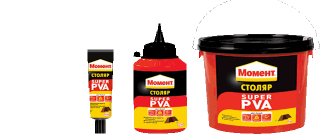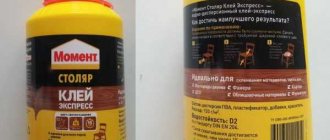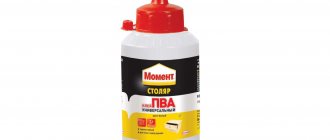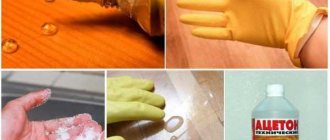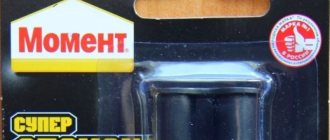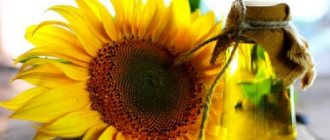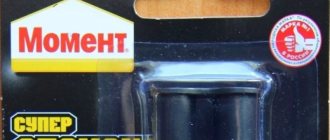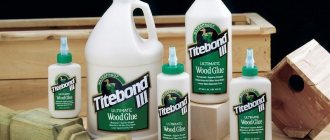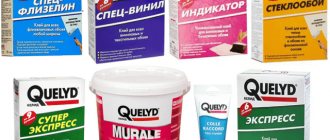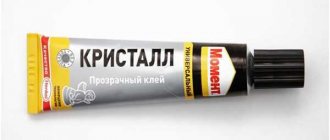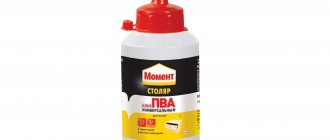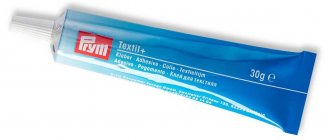Peculiarities
The composition of "Stolyar" includes a polyvinyl acetate dispersion with the inclusion of special plasticizers and additives that improve the adhesive properties of the material and increase the reliability of the connection. In the manufacturing process of Moment glue, no toxic or poisonous substances are used, which makes the material environmentally friendly and allows it to be used in the repair of household items. The chemical safety of the product is confirmed by a quality certificate and certificates of conformity that meet strict European standards.
Thanks to special additives, the adhesive composition does not disturb the structure of wood fibers.
Once dry it is invisible. The scope of application of the product is quite wide. The glue is successfully used when working with any type of natural wood, plywood, chipboard and fiberboard, cardboard, veneer and laminate.
It is allowed to work with the composition at temperatures above 10 degrees and relative humidity no more than 80%. When performing work at low temperatures, the glue may lose its high adhesive properties, and the gluing will turn out to be of poor quality. The average material consumption is about 150 grams per square meter of surface. The dried composition is compatible with all types of paint and varnish products, therefore, if necessary, the glued item can be painted or varnished.
Features of D3 glue - composition and scope of application
Water-dispersed adhesive PVA D 3 is intended for connection with various types of wood products. Can be used to attach certain types of facing materials. Often chosen for the production of windows and doors, joining wood flooring. But the most common is the use of D 3 glue for the manufacture of furniture structures.
At the same time, it can also be used for veneering, due to its high adhesion rates.
The base uses polyvinyl acetate dispersion. PVA D 3 has a white color, which is obtained by internal plasticization; after completion of the hardening process, it becomes transparent and is highly durable.
Often chosen for the production of windows and doors, joining wood flooring.
What types of wood is it suitable for?
Moisture-resistant PVA glue D 3 can be used for any type of wood, in addition to chipboard, MDF, veneer, plywood, facing, leather, glass, cardboard, tile, and paper materials. They glue linoleum and glass wallpaper.
It is added to cement-chalk mortars when repair work is carried out outside and inside the building. Widely used in carpentry, involved in the production of musical instruments, packaging products, book products and more. It perfectly connects wood with glass, film, plastic and other materials.
Often chosen for the production of windows and doors, joining wood flooring.
Advantages and disadvantages
3 D glue is popular due to a number of positive qualities that are determined by its technical characteristics. The following advantages of the composition can be highlighted:
- Creates a connection with a high degree of strength;
- Moisture resistance. This product has received a water resistance class according to DIN EN 204/D3, which determines the possibility of its use in rooms where there is high humidity, condensation forms, and there is constant exposure to moisture. For example, in the bathroom, in the kitchen. At the same time, it can be used for gluing objects used outdoors, common gluing of furniture located in gazebos, on open verandas, etc.;
- Transparency. Thanks to this feature, there is no need to select shades for the material used, but if desired, the layer can be painted with paint and varnish products;
- Environmental friendliness. The solution does not contain harmful components, it does not emit an unpleasant odor, it can be used for interior work, it is safe for human health;
- Frost resistance. The composition can withstand up to 5 freezing cycles, which is important for garden items;
- It does not paint the parts being glued, so they will not be damaged externally, the only thing is that it may slightly change the shade of the wood containing tanning elements;
- Heat resistance, withstands impacts up to +100 degrees;
- The seam has elasticity.
Among the negative qualities, one can note the inability to use tools made of zinc, aluminum, copper and several other materials to apply glue.
It can be used for gluing objects used outdoors; it is commonly used for gluing furniture located in gazebos.
Advantages and disadvantages
High consumer demand for Moment Joiner glue is due to a number of positive properties of the material.
- The moisture resistance of the glue allows you to use objects glued together by “Stolyar” in conditions of high humidity.
- Thanks to its good heat resistance, the adhesive can withstand temperature loads of up to 70 degrees. This is very convenient when working with veneered elements that require heating during installation.
- Excellent adhesion and a short setting period allow you to quickly form a strong and durable joint. “Stolyar” is an express composition, so working with it significantly reduces repair time.
- The time for complete drying of the joint seam is no more than 15 minutes.
- Durability of the connection. The glued surfaces will not lose reliable adhesion throughout the entire service life of the repaired product.
The disadvantages include the low frost resistance of the composition and certain requirements for wood moisture content: repaired products must be used at positive temperatures, and the wood moisture content should not exceed 18%.
Characteristic
The main ingredient in Moment Joiner glue is PVA. In addition, it contains a plasticizer, dye and additives that increase the strength and heat resistance of the glue. After drying, the substance has the color of light wood.
Types of glue vary in water resistance. Thus, D2 can withstand short-term exposure to water, and “super d3 waterproof” has a high degree of reliability when in contact with water. Sold in tubes and jars of various sizes: from 125 ml to several kilograms.
“Moment joiner” has gained popularity as a substance for gluing wooden objects, but its scope of application is not limited to this.
For what materials can the product be used:
- for wood,
- veneer,
- plastic,
- foam rubber,
- cardboard,
- coarse fabrics,
- accessories.
Positive properties:
- Heat resistant.
- Resistant to humidity.
- Sets quickly.
- Does not attract pests.
- Suitable for all types of wood.
- Invisible after drying.
- There are no toxic impurities that can damage the structure of the wood.
Why do we need additives and modifiers in PVA?
According to the instructions in the instructions, additives and modifiers are used in the composition. They are used to improve the stability of the resulting adhesive joint. Earlier types, which were created without additional substances, could not withstand exposure to moisture. For this reason, glued products could not be used for a long time, because it is not always possible to avoid moisture. Such products were not durable.
Modifiers help to obtain the required viscosity, application of the composition is more convenient, and it is easier to obtain a uniform coating without dripping. Additives also help give the solution good elasticity and plasticity.
Modifiers help to obtain the required viscosity.
Fillers and thickeners must be of different quality; sometimes unscrupulous manufacturers use cheap additives, which leads to a decrease in the quality of the applied seam; the characteristics are indicated as high, but in reality they are not confirmed.
Therefore, it is important to choose products from trusted manufacturers who produce products in accordance with GOST. You can request a certificate of quality from the seller to ensure that the product is from a reputable, compliant manufacturer.
It is important to choose products from trusted manufacturers.
PVA D 3 waterproof is a good quality glue. It is safe for human health. Therefore, it can be used for products that are used indoors, while it is highly resistant to moisture and can withstand its increased influence for a long time, maintaining a reliable connection. Due to its positive qualities, the product is popular among professionals and ordinary people.
Instructions for use
Precautionary measures should only be taken if you have an allergic reaction to a specific group of repellents. The fact is that the plasticizer, dibutyl phthalate, in its pure form is used to repel mosquitoes, and its concentration in PVA glue is super, quite high. To prevent possible redness of the skin on your hands, we recommend using latex gloves. Otherwise, this glue is safe.
To understand how to properly glue with PVA glue, you need to firmly understand the following rules:
- The surfaces to be bonded should not be dusty.
- Degreasing is the key to a quality seam.
- Reliable fixation during the day is an important condition for polymerization.
- Maintaining temperature conditions is the foundation for successful work.
After mastering the above rules, the instructions are quite simple. The optimal temperature for gluing is 18-25°C. Please note that the parts themselves must have this temperature, and not just the air in the room. The surfaces to be bonded must be cleaned of all excess. This is best done with fine sandpaper. Moreover, the use of sandpaper will increase the surface roughness, which leads to an increase in the contact area and thereby improve cohesion.
The cleaned and sanded surface must be wiped with a highly volatile solvent. In addition to degreasing, this procedure will remove dust. The presence of dust sharply reduces the adhesion of glue to the part.
The PVA dispersion is applied in a thin layer to both surfaces and left for 6-8 minutes. During this time, on each part, the glue penetrates into the thickness of the material by several microns and begins the polymerization process. Then the surfaces to be glued are pressed against each other and securely fixed. Please note that, unlike adhesives containing solvents, when working with PVA, the duration of fixation is critical. The minimum time for reliable setting is 24 hours at a temperature of 20-25°C.
Important! Complete polymerization of polyvinyl acetate takes place within 7 days!
Only after this time does the adhesive joint acquire the declared characteristics.
Of course, if you glue cardboard, you don’t have to wait that long. But when working with furniture, compliance with the exposure period is extremely desirable. When gluing wood, carefully following the instructions leads to a paradoxical effect - the adhesive seam of PVA glue is super, it becomes stronger than the product itself. In other words, if the load is exceeded, the wood itself will break, and not the glue seam!
It is best to remove excess glue immediately after application. This can be done with a damp cloth. After drying and complete polymerization, only scraping with a knife or sandpaper is possible. The action of household solvents causes swelling of the polymer film and does not lead to dissolution.
- Compound
- Mezdrovy
- Isinglass
- Bone
- Casein
- Moisture resistant
- How to prepare the mixture
- Titebond
- Moment
- Titanium
- Selection rules
Carpenter's glue is intended for joining parts made of paper, cardboard, wooden boards, bars, and hardboard. The material is inexpensive, safe, and has a natural composition.
Advice from experts
If a larger quantity of material was purchased in relation to the required quantity, then storage rules must be followed.
In this case, simple tips will help:
- The formed film on the surface of the glue, if it was purchased in buckets, must be removed.
- Any mixture that gets on the skin is removed using running water. To avoid such situations, you need to wear latex gloves.
- After the expiration date stated by the manufacturer, the glue is disposed of. Disposal is carried out in accordance with the requirements for recycling plastic containers.
- Tools that have come into contact with the adhesive composition are washed under running water after work. To make work easier, use soft rags.
- Dried glue must be removed mechanically.
Packaging and storage
Adhesives are available in a variety of containers. In everyday life, the most popular are 125 g tubes, as well as 250 g jars. Small packages are equipped with caps, making them more convenient to work with (you can screw the product tightly at any time). Typically, this glue is used to create crafts, carry out minor repairs to furniture and interior items, and for gluing corners of wallpaper.
There are also 750 g jars on sale. They are used for repair work, and are often added to wallpaper glue to enhance adhesion (to hold heavy canvases). Professionals usually choose 3 kg buckets, while furniture factories usually choose 30 kg buckets. Packages of 3 kg have a sealed lid, like larger containers, although under production conditions it is not necessary to store the glue for a long time. Instant Grip glue is available in additional 100g and 200g packs as it is often used for small jobs that require a quick and reliable bond.
The product should be stored at +5...+30 degrees in the original packaging, tightly twisted and closed. It must be protected from high humidity and direct sunlight. Despite its moderate frost resistance, it is better not to freeze the glue unless absolutely necessary. Otherwise, the frozen product should be brought into a room at room temperature and allowed to melt naturally. When used correctly, Moment adhesives from the Joiner series will become reliable assistants on construction sites and in repairs.
Kinds
Adhesive “Moment Joiner” is presented in modern markets in the form of 5 series.
They differ in the composition of the main substances, color, conditions of use, setting period and complete hardening.
- “Moment Joiner glue express” is a universal moisture-resistant material, suitable for working with wood of any species. They can be used to glue plywood, wood-fiber and particle board substrates, and veneer boards. The time for complete setting is influenced by the air temperature and humidity of the wood.
2. “Moment Joiner Super PVA” is suitable for working not only with wood, but also with chipboard, fiberboard and laminate. It can be spotted among other varieties by its bright red jar. It, unlike the previous variety, has a transparent structure. After drying, it is almost invisible on the surface. But it is suitable for work in dry and moderately damp rooms, as it belongs to class D2.
3. “Moment Joiner super PVA D3 waterproof” is a universal material that differs from other varieties in its optimal degree of frost resistance. It is not afraid of repeated freezing and thawing. It can fasten not only wooden, but also laminated bases. You need to choose this variety for working in rooms with high humidity levels.
4. “Moment Joiner PVA universal” has a water-dispersion base and is also suitable for working with any recommended materials. It has a shortened period of complete setting, a transparent consistency, and does not leave streaks, cloudy spots or colored highlights on the surface. In order for the glue to create the most dense, reliable and durable adhesion, you need to ensure that the surfaces are firmly fixed for 20 minutes.
5. “Moment Joiner Instant Grip” is an acrylic water-dispersion composition, suitable for working with any type of wood, it sets in 10 seconds, so it requires certain application skills. It is very simple and easy to apply and does not leave any marks on the surface. You can use it to fasten wood to metal, PVC to plastic. It can withstand 5 cycles of short-term freezing without damage.
Tips and tricks:
More than wood glue:
Glue Moment Joiner Express can also be used for gluing paper, cardboard or even straw. With its help, you can create crafts with your children or make a gift for a loved one with your own hands. You can use Moment Joiner Express for any task, from heavy repairs to the smallest DIY work.
How to fix the surfaces to be glued?
The parts to be glued must be pressed against each other and fixed for 15-20 minutes. Professionals use a vice or clamps. If such tools are not at hand, the parts may be crushed by books, a bucket of water, or other heavy objects.
Advantages of the material Moment Joiner Super PVA
The adhesive is characterized by increased gluing rigidity, ensuring durability of the finished products. Popular in carpentry due to the following advantages:
- Moisture resistant - class D2, resistant to air humidity, short-term contact with water;
- Forms a transparent seam after drying and does not stain the wood;
- Sets and dries quickly, does not require long-term fixation;
- Provides high connection strength.
The most universal PVA glue for wooden bases of any origin, be it hard wood (oak, ash, beech, walnut, etc.) or veneer, MDF, chipboard, is Moment Joiner. It is also well suited for gluing leather, fabric, paper and even some types of plastic. That is why it is very popular among both professional workers and home craftsmen. We can say that its versatility has captivated many craftsmen. This heat-resistant, quick-setting, high-strength adhesive composition is widely used for repairing and assembling furniture, gluing laminate, veneer, various accessories and other types of construction work. High adhesion is achieved through the use of PVA in the dispersion, as well as various additives, plasticizers and dyes.
Reviews
Among the advantages I would like to note the following: the glue holds the two parts together very well. At the same time, it dries quickly and after drying retains its transparency. If the glue has dried, then removing it is a real problem.
Alexey, Vladivostok
I bought glue to glue a plywood craft, but I was busy renovating the house and couldn’t get around to it. I heard somewhere that PVA glue works great for wallpapering. I just had a small area lagging behind, and I decided to try it - the result amazed me.
Irina, Stavropol region
Storage:
Store tightly closed at temperatures from +5C to +30C.
1.
Make sure surfaces are dry, clean and non-greasy. At least one of the surfaces must absorb water.
2.
Before gluing, keep the materials at room temperature (from +18C to +25C).
3.
Apply glue to one of the surfaces in a thin, even layer.
4.
Connect the surfaces and press them together for 15-20 minutes. When gluing, the ambient temperature should not be lower than +6C.
5.
Glued parts can be processed after 24 hours.
Glue technology
The rules for using glue are standard: cleaning the surface, distributing the composition, joining parts. The product must then be left for 24 hours.
If, after touching and pressing the parts, some of the product comes out, it must be removed as soon as possible with a damp cloth so that no traces of smudges remain. In addition, it is important to observe the gluing operating temperature, which is at least +6 degrees.
Additional Tips
When constantly working with PVA Moment glue, you need to follow simple tips:
- in the period between applying glue it should be kept in an airtight container with a tightly closed lid;
- It is allowed to apply paint to parts treated with adhesive mass only a day after they are connected;
- The product can be distributed more evenly with a wide brush.
Compound
The basis of wood glue, the main agent is animal protein.
Depending on the type of raw material, there are glues:
- fleshy,
- fishy,
- bone,
- casein,
- polyvinyl acetate (PVA),
- moisture resistant.
All types are used for carpentry work.
Mezdrovy
The main active ingredient is obtained by processing animal skin. Protein is the subcutaneous layer without fatty tissue. It contains oligopeptides. They contain cysteine, which forms bonding bridges for reliable connection of parts.
Hide wood glue is produced in the form:
- powder,
- tiles,
- scales.
Isinglass
Fins, scales, and swim bladders are used to produce fish glue. The result is a solution suitable for gluing similar and dissimilar surfaces. The only drawback is the high price.
Glue is produced in the form of dry flakes and granules.
Bone
Made from the bone remains of animals. Contains:
- collagen,
- gelatin,
- cysteine.
These substances are viscous and reliably glue the surfaces of wooden products. The price of the material is low. You should choose transparent compounds: they are better than unrefined, cloudy, with impurities
.
Casein
Includes:
- casein,
- kerosene,
- copper sulfate,
- sodium fluoride,
- slaked lime.
Flaws:
- Significant shrinkage in volume.
- Change in color of bonded surfaces.
- The prepared solution has a short shelf life of several hours.
Holds wood parts together well.
The raw materials for preparing casein adhesive solution are available in the form of dry powder.
Application
For maximum bonding reliability, a number of conditions must be met. Therefore, before gluing, read the manufacturer's recommendations and instructions. Below are general rules for handling Moment Joiner glue.
Instructions and rules for working with wood glue:
- The tip of the nozzle is cut depending on the width of the required seam. The thinner it is, the smaller the cut is made.
- Before treatment, surfaces are cleaned of dust and debris.
- To remove excess fat, a solvent is used. The measure is necessary to improve the adhesion of the glue to the surface.
- One surface is treated with glue using a spatula, roller or brush.
- The surfaces to be joined must be kept fixed for about 10-15 minutes for the glue to work better. “Moment Express Joiner” sets much faster, so it is used for processing small parts.
- Time for complete hardening is at least 24 hours.
- The higher the humidity of the wood, the longer the glue will take to set.
- You can use clamps or heavy objects for fastening.
- The glue temperature should not be lower than +10 degrees.
Advice! If hard wood is being processed, then both parts are covered with glue.
Moment Joiner glue is a worthy option for woodworking and more. It is used to assemble new furniture and repair old ones. This product is an alternative to nails and screws, which only spoil the look.
When repairing or assembling furniture, wooden models, laminate and other materials of such a structure, it is necessary to use glue - “Moment Joiner” is suitable for these purposes. In addition to the above materials, it is used when working with veneer, coarse fabrics, cardboard, fittings and plastic. It earned trust, so it became a common wood glue.
Instructions and operating rules
Before gluing the parts, you need to properly prepare both bases. To do this, the surfaces are cleaned of dust and dirt, old paint is removed from them, and grease is removed by wiping with alcohol and acetone. The optimal moisture content of wood is 8-10%, the limit of this indicator is 18%. At a humidity of 12-14% you need to be prepared for an increase in the setting time of the glue. It is advisable that the room temperature be about 20 degrees.
The procedure for working with glue is as follows:
- Cut the tip of the tube nozzle to a size corresponding to the width of the required seam. If you purchased “Moment” in a jar or bucket, open the packaging.
- Make sure the adhesive and materials being joined are at room temperature. It is better if they are heated to +23...+25 degrees.
- Apply a thin layer of the product with a brush, roller or rubber spatula. To achieve better adhesion, both surfaces should be treated with glue.
- Fix the products for 10-15 minutes for the glue to set. If the moisture content of the wood is high, this time must be increased. Vices and heavy objects can be used as clamps. It is best to leave the products in this position for a day - this is how long the adhesive seam needs until it is ready for use.
- Remains of glue that extend beyond the seam must be removed mechanically (for example, wiped off with a damp cloth).
You need to be careful when working with Instant Grip glue. The parts should be folded correctly right away, because they will set almost immediately. For all adhesives from the Moment Joiner line, it is the high-quality initial fixation that is important, so immediately after applying the product the strongest pressure is ensured.
How to prepare the mixture
To prepare the working material, take ready-made grain, dry powders, tiles, granules. They are thoroughly crushed and diluted with warm water according to the instructions. Wait for the active components to swell. Then they use it. Store in a hermetically sealed container. All formulations, except casein, retain adhesive properties for several days.
The cooking method is described in the instructions on the package.
. Mixtures from different manufacturers may differ in composition. Consistency matters. The description of the specific glue indicates the required amount of water. It is designed to produce a mixture of a certain viscosity. If a more liquid material is needed for work, the liquid is added in small portions, and the paste is thoroughly mixed each time.
Before gluing the surfaces to each other, they are cleaned and degreased. Then a thin layer of solution is applied to one of the parts and the surfaces are pressed. To increase the effect, a weight is placed on top; it prevents the workpieces from moving apart. Gluing occurs in 2–3 hours, drying in 2–3 days. The exact period and conditions are specified in the technical characteristics of each composition.
| : |
